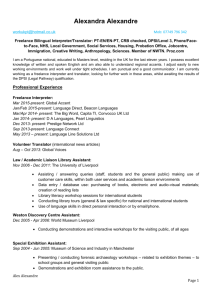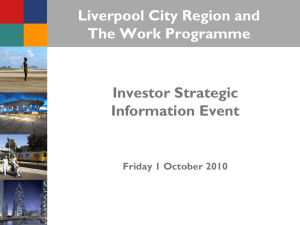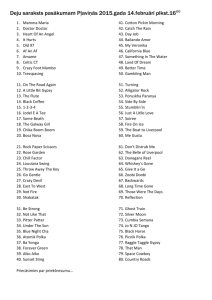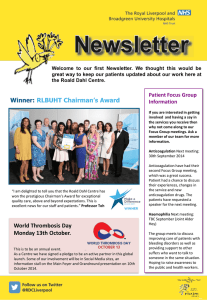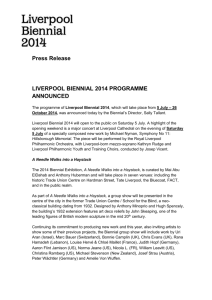(.doc) - Liverpool Biennial
advertisement
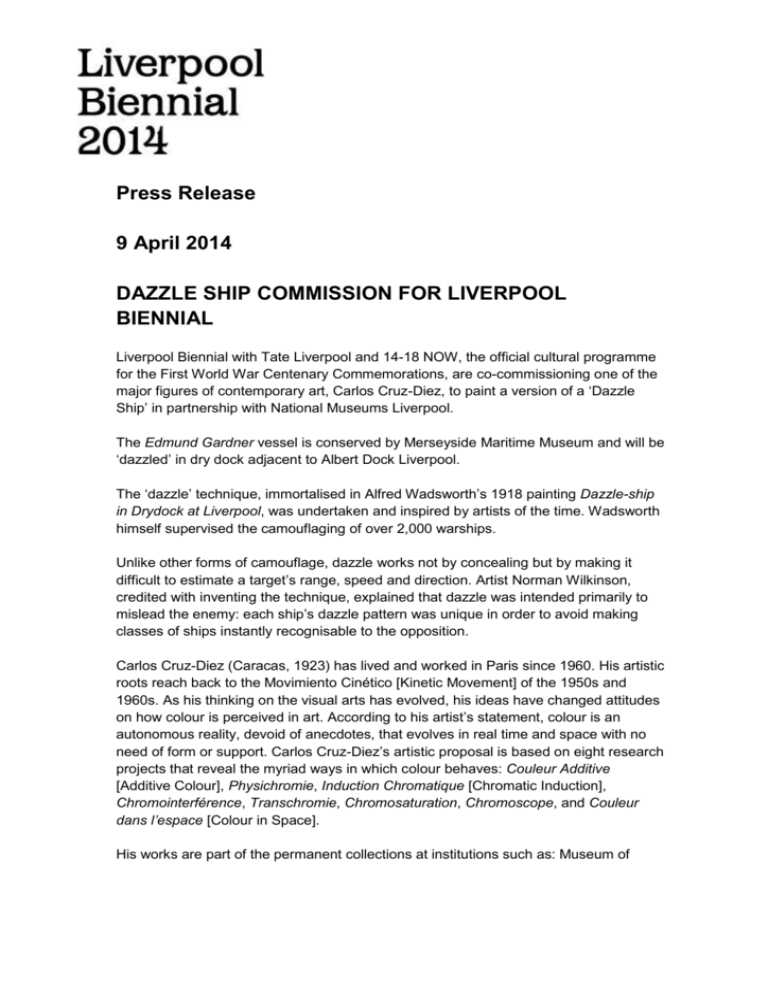
Press Release 9 April 2014 DAZZLE SHIP COMMISSION FOR LIVERPOOL BIENNIAL Liverpool Biennial with Tate Liverpool and 14-18 NOW, the official cultural programme for the First World War Centenary Commemorations, are co-commissioning one of the major figures of contemporary art, Carlos Cruz-Diez, to paint a version of a ‘Dazzle Ship’ in partnership with National Museums Liverpool. The Edmund Gardner vessel is conserved by Merseyside Maritime Museum and will be ‘dazzled’ in dry dock adjacent to Albert Dock Liverpool. The ‘dazzle’ technique, immortalised in Alfred Wadsworth’s 1918 painting Dazzle-ship in Drydock at Liverpool, was undertaken and inspired by artists of the time. Wadsworth himself supervised the camouflaging of over 2,000 warships. Unlike other forms of camouflage, dazzle works not by concealing but by making it difficult to estimate a target’s range, speed and direction. Artist Norman Wilkinson, credited with inventing the technique, explained that dazzle was intended primarily to mislead the enemy: each ship’s dazzle pattern was unique in order to avoid making classes of ships instantly recognisable to the opposition. Carlos Cruz-Diez (Caracas, 1923) has lived and worked in Paris since 1960. His artistic roots reach back to the Movimiento Cinético [Kinetic Movement] of the 1950s and 1960s. As his thinking on the visual arts has evolved, his ideas have changed attitudes on how colour is perceived in art. According to his artist’s statement, colour is an autonomous reality, devoid of anecdotes, that evolves in real time and space with no need of form or support. Carlos Cruz-Diez’s artistic proposal is based on eight research projects that reveal the myriad ways in which colour behaves: Couleur Additive [Additive Colour], Physichromie, Induction Chromatique [Chromatic Induction], Chromointerférence, Transchromie, Chromosaturation, Chromoscope, and Couleur dans l’espace [Colour in Space]. His works are part of the permanent collections at institutions such as: Museum of Modern Art, New York; Tate Modern, London; Centre Georges Pompidou, Paris; Museum of Fine Arts, Houston; Wallraf-Richartz Museum, Cologne; Musée d’Art Moderne de la Ville de Paris. Among his recent exhibitions are: "Carlos Cruz-Diez: Color in Space and Time", Museum of Fine Arts, Houston, United States (2011), "Carlos Cruz-Diez: El color en el espacio y en el tiempo", Museo de Arte Latinoamericano (MALBA - Fundación Constantini), Buenos Aires, Argentina (2011), "Cruz-Diez: Color in Space", Jeonbuk Province Art Museum, Jeonbuk, South Korea (2012), “Carlos Cruz-Diez: A cor no espaço e no tempo” Pinacoteca do estado Sao Paulo, Brazil (2012), "Carlos Cruz-Diez: Circumstance and Ambiguity of Color", Central Academy of Fine Arts (CAFA Museum), Beijing, China (2013), “Light Show”, Hayward Gallery, London, U.K. (2013), “La Invención Concreta: Colección Patricia Phelps de Cisneros”, Museo Nacional Centro de Arte Reina Sofía, Madrid, Spain (2013), “Dynamo. Un siècle de lumière et de mouvement dans l’art. 1913-2013”, Galeries nationales du Grand Palais, Paris, France (2013) Liverpool Biennial’s dazzle ship is part of Monuments from the Future: a new commissioning initiative between Tate Liverpool and the Biennial which invites artists and architects to bring large-scale imaginary monuments from the future into the present. In order to fulfil this paradoxical task, artists will collaborate with professional futurologists (social scientists who predict possible future scenarios) to determine possible future circumstances and set of events for which a new monument can be imagined and produced. This project will slowly turn Liverpool into a sci-fi sculpture park making use of Liverpool’s industrial archaeology to celebrate its possible new futures. Media Enquiries: Erica Bolton/Jane Quinn Bolton & Quinn +44 (0) 20 7221 5000 erica@boltonquinn.com / jq@boltonquinn.com Notes to Editors: First World War Centenary Partnership Programme 14-18 NOW is a member of the First World War Centenary Partnership and is an independent programme hosted within Imperial War Museums. The First World War Centenary Partnership was established by IWM (Imperial War Museums) in 2010 and to date has over 2,500 members from across 45 countries. The Partnership is presenting a collective programme of activities and events to mark the centenary, developed at grass roots levels. This diverse and far-reaching programme has been developed to reflect how people want to remember, commemorate and debate the conflict in their own communities, in a way that is meaningful for them. 1914.org is the official website for the First World War Centenary Partnership. Throughout the centenary new events and activities will be added each week to the events calendar, produced in partnership with Culture 24. A full press pack for 14-18 NOW is available, please contact the press office for more details. Carlos Cruz-Diez - Biography Carlos Cruz-Diez born in Caracas, 1923; lives in Paris. Cruz-Diez is one of the great figures of kinetic-optic art. His art proposal, one of the most original of that movement, reveals him as one of the last colour. His research is based on three chromatic conditions: subtractive, additive and reflected, and has brought art a new way of understanding the phenomenon of colour, greatly expanding its perceptual universe. Cruz-Diez's work revolves around colour conceived as an autonomous reality, progressing in space and real time without past or future - in a perpetual present. In his works, colour appears as a reality that can exist without the help of traditional form. Cruz-Diez´s works are in the permanent collections of institutions such as the Museum of Modern Art (MoMA), New York; Tate, London; Centre Georges Pompidou, Paris; Museum of Fine Arts, Houston; Musée d´Art Contemporain de Montreal; WallrafRichartz Museum, Cologne; and the Musée d´Art Moderne de la Ville de Paris. In my works, colour appears and disappears in the course of the dialogue that is generated in real time and space. Simultaneously, it unquestionably appears that the acquired information as well as the knowledge stored in the course of our living experience, aren’t probably true ... at least partially. It is also possible that with colour, approached through a "basic vision" devoid of predetermined meaning, we are able to awaken other sensitive apprehension mechanisms more subtle and complex than those imposed by cultural conditioning and mass information of contemporary societies. Carlos Cruz-Diez in Réflexion sur la couleur, Édition des Beaux-Arts, 2013 [or. ed. 1989) The Carlos-Cruz Foundation The Cruz-Diez Foundation is an organisation committed to preserving, developing, exhibiting, and researching the artistic and conceptual legacy of Carlos Cruz-Diez, one of the twentieth century’s seminal thinkers in the field of color. We believe that the arts are the finest communication system ever invented by mankind. Our goal is to stimulate and nurture the kind of intellectual inquiry that leads to new forms of expression. About Liverpool Biennial Liverpool Biennial, an ongoing platform for research, commissioning and presenting international art, education and debate, is the UK Biennial of Contemporary Art. In 2012, it attracted over half a million visitors over its ten weeks run and since its founding in 1999, has shown the work of over 350 artists from 72 countries. Since 2004, Liverpool Biennial has contributed over £98.9 million to Liverpool’s economy. Liverpool today offers the richest visual arts environment anywhere in the UK outside London. It has more galleries and museums, and commissions more new art than any other city except the capital and was European Capital of Culture in 2008. Liverpool Biennial festival takes place in a wide range of locations across the city, from established museums and galleries to unusual and unexpected place Liverpool Biennial is funded and supported by: Founding Supporter James Moores The Dazzle Ship project is also funded and supported by:

